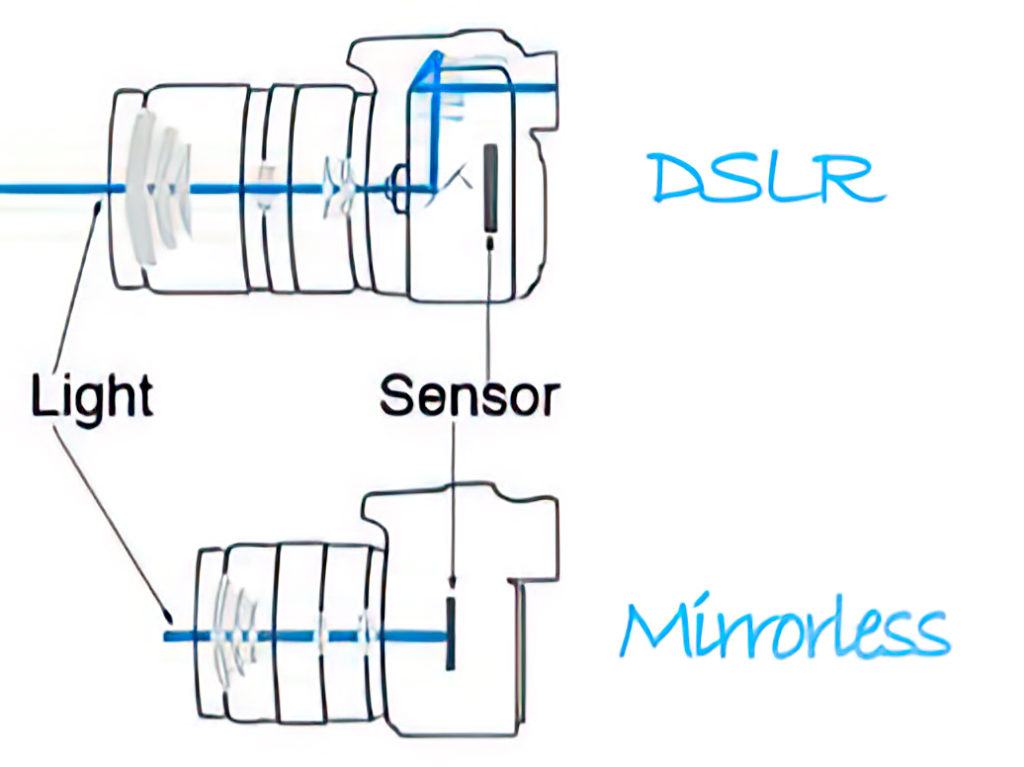What is a mirrorless camera?
The hype around mirrorless cameras is increasing as they get better and better but what exactly is a mirrorless camera?
What is a mirrorless camera?
A mirrorless camera is a digital camera that, as its name implies, lacks a mirror. It also has an electronic viewfinder. The latest Nikon mirrorless camera, the Nikon Z9 has a Real-Live Viewfinder.
With a mirrorless camera, the light passes straight through the lens onto the sensor and the digital information is sent to an electronic viewfinder (EVF) or LCD screen.
With a DSLR camera, the light passes through the lens and is then reflected by the mirror (which is in front of the sensor) to the pentaprism which then transmits it to an optical viewfinder.

What should I buy, a DSLR camera or a mirrorless camera?
The answer to this question depends on your skill level, what you want to do with your images/videos, your budget, and your personal preferences.
For travel and street photography a mirrorless camera is a wonderful option. Mirrorless cameras are more compact and lighter due to the lack of a mirror. Some mirrorless cameras are completely silent therefore you can be more discreet. They have an electronic shutter.
If you take video, then mirrorless cameras are the way to go.
A few years back if you were a sports photographer or wildlife photographer then a DSLR was still the better option because you couldn’t hope to track for example a bird with an electronic viewfinder. However, the latest releases of both Canon and Nikon mirrorless cameras have changed this. The autofocus also includes “animal eye” mode which hunts out and locks onto eyes which is exactly what you want!
There is no doubt that mirrorless cameras are the way of the future. Many big camera brands are no longer bringing out new model DSLRs. Smartphone cameras are causing the demise of the DSLR!
If you are new to photography and want to buy a camera, then I would suggest buying a mirrorless camera. If you already have camera gear then it depends on your preferences. If you need portability and like the option of previewing your image, then mirrorless is great. If you prefer an optic viewfinder and longer battery life, then stick with your DSLR.

What is the difference between an optic viewfinder and an electronic viewfinder?
We have been speaking about viewfinders quite a bit, so what is the difference between the two types of viewfinders?
An optic viewfinder (OVF) uses mirrors and prisms to render the view of a scene. Because it shows you the actual scene, it is clear, and lifelike. OVFs are on DSLR cameras. OVFs give an unaltered view of the scene and make it easy to compose your shot. You can look through the optical viewfinder even if your camera is off.
Yet, OVFs show you what your eyes see and not necessarily what your camera sensor sees. Only after you have taken the photo will you see if your image is correctly exposed.
Electronic viewfinders (EVF) on the other hand use the information from the imaging sensor to display an image on a small LCD screen on the back of a mirrorless camera. EVF is digital so it can show a whole lot of different information and data as well as a representation of the scene you are photographing. EVFs show exactly what your scene will look like when photographed. You can see in real-time whether your shot is exposed correctly. Thus, you can make any adjustments that you require before you take the shot. EVFs also let you preview the scene in different modes, even black and white. They, however, use a lot of battery power and in low light can get quite grainy.

So, in summary, the main differences between a DSLR and a mirrorless camera are the following:
DSLR vs Mirrorless
DSLR:
- Battery power lasts longer
- Greater selection of lenses and accessories
- Optical Viewfinder
- Slightly cheaper
Mirrorless:
- Light and compact
- Better video recording capabilities
- Electronic Viewfinder – the ability to preview the scene
- Quiet and less obtrusive
- Better image stabilization
The bottom line is that mirrorless cameras are just going to get better and better. For now, I’m still sticking with my trusty DSLR. Which ever camera you choose you will be able to make stunning photographs with!

